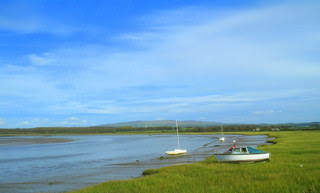I set off this morning in good 'birding' spirits with the intention of stepping outside my kind of birding, to spend the day looking for 'other peoples birds' with Glasson Dock, and Arnside the priorities, and a look in on the Eric Morecambe Complex at Leighton Moss to see if I could prove the 'regulars' simply weren't doing the job right. It all ended about seven hours later with a massive - in twitching jargon - 'dip', but I wouldn't have it any other way, I would'nt be remotely interested in birds if they were always there to order....would you?
I was on the job at Glasson Dock and spent a full 2.5 hours watching the tide come in and push the birds ever closer until the mud was eventually covered and I left minus the Lesser Yellowlegs despite grilling c.200 Redshank coming and going - and others - until I was blue in the face just managing in between to log three adult Mediterranean Gulls, take note of c.650 Golden Plover and 45 Bar-tailed Godwit.
Forty minutes later I'm in the Eric Morecambe hide to take note of 14 species including at least 500 Black-tailed Godwit, 9 Greenshank, 2 Spotted Redshank, a Ruff, and not very common on the complex, a single Knot and Bar-tailed Godwit, not everyone realises these are two of 'one or two' species of wader not all that regular/common on here. A solitary Pink-footed Goose was of note.
Buff-breasted Sandpiper. Brian Rafferty
Now I'm about to join some seasoned birders already in place when I arrive at Arnside as the tide ebbed, but despite allowing myself about one hour here I/we found no sign of the Buff-breasted Sandpiper, nor....
Pectoral Sandpiper. Dave Appleton.
....any Pectoral Sandpipers and had to leave by 3.30pm only to see the Buff-breasted Sandpiper, two Pectoral Sandpipers, three Little Stints, and a Yellowlegs species reported there later....Oh Dear!!
Marsh Tit. Mike Watson
Three Little Egret were on the marsh, and a Marsh Tit was nice in the wooded area behind were I was stood on the embankment at Arnside, a very localised breeder in our area and mainly restricted to the Lune Valley, Silverdale/Arnside, and south-east Cumbria.
The sting in the tail....
The Lesser Yellowlegs was reported on the Lune Estuary, Glasson Dock at 6.10pm....Oh Dear again!!
I met a nice couple in the Eric Morecambe hide today, but despite seeing them at Leighton Moss on and off for c.150 years I still don't know their name, but they know who they are and I know they look in on Birds2blog on a daily basis which I much appreciate.....good to have seen you again today 'nice couple'.
Thanks to BR/DA/MW for the photographs which are much appreciated.
Thanks to BR/DA/MW for the photographs which are much appreciated.







































